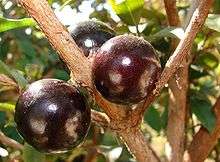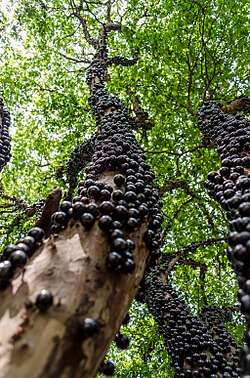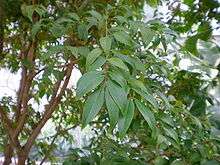Jabuticaba
| Jabuticaba | |
|---|---|
 | |
| Scientific classification | |
| Kingdom: | Plantae |
| Clade: | Angiosperms |
| Clade: | Eudicots |
| Clade: | Rosids |
| Order: | Myrtales |
| Family: | Myrtaceae |
| Genus: | Plinia |
| Species: | P. cauliflora |
| Binomial name | |
| Plinia cauliflora (Mart.) Kausel | |
| Synonyms[1] | |
| |
Plinia cauliflora, the Brazilian grapetree,[2] jaboticaba or jabuticaba,[2] is a tree in the family Myrtaceae, native to Minas Gerais, Goiás and São Paulo states in Brazil.[2] Related species in the genus Myrciaria, often referred to by the same common names, are native to Brazil, Argentina, Paraguay, Peru and Bolivia. The tree is grown for its purplish-black, white-pulped fruits which grow directly on the trunk; they can be eaten raw or be used to make jellies, juice or wine.
Description
Tree
.jpg)

The tree is a slow-growing evergreen that can reach a height of 15 meters if not pruned. It has salmon-colored leaves when they are young, which turn green as they mature.
The tree prefers moist, rich, lightly acidic soil. It is widely adaptable, however, and grows satisfactorily even on alkaline beach-sand type soils, so long as they are tended and irrigated. Its flowers are white and grow directly from its trunk in a cauliflorous habit. In an uncultivated state, the tree may flower and fruit only once or twice a year. When continuously irrigated it flowers frequently, and fresh fruit can be available year-round in tropical regions.
Fruit

The fruit is a thick-skinned berry and typically measures 3–4 cm in diameter. The fruit resembles that of a slip-skin grape. It has a thick, purple, astringent skin that encases a sweet, white or rosy pink gelatinous flesh. Embedded within the flesh are one to four large seeds, which vary in shape depending on the species.[3]
Common in Brazilian markets, jabuticabas are largely eaten fresh; their popularity has been likened to that of grapes in the United States. Fresh fruit may begin to ferment 3 to 4 days after harvest, so they are often used to make jams, tarts, strong wines, and liqueurs. Due to the short shelf-life, fresh jabuticaba fruit is rare in markets outside of areas of cultivation.
In Brazil the fruit of several related species, namely Myrciaria tenella and M. trunciflora, share the same common name. While all jabuticaba species are subtropical and can tolerate mild, brief frosts, some species may be marginally more cold-tolerant.
Commercial cultivation of the fruit in the Northern Hemisphere is more restricted by slow growth and the short shelf-life of fruit than by temperature requirements. Grafted plants may bear fruit in five years; seed-grown trees may take 10 to 20 years to bear fruit, though their slow growth and small size when immature make them popular as bonsai or container ornamental plants in temperate regions.
Jabuticabas are fairly adaptable to various kinds of growing conditions, tolerating sand or rich topsoil. They are intolerant of salty soils or salt spray. They are tolerant of mild drought, though fruit production may be reduced, and irrigation will be required in extended or severe droughts.
Cultural aspects
The name jabuticaba, derived from the Tupi word jaboti/jabuti (tortoise) + caba (place), meaning the place where you find tortoises. The Guarani name is yvapurũ: yva means fruit and the onomatopoeic word purũ describes the crunching sound the fruit produces when bitten. The jabuticaba tree, which appears as a charge on the coat of arms of Contagem, Minas Gerais, Brazil,[4] has become a widely used species in the art of bonsai, particularly in Taiwan and parts of the Caribbean.
References
- ↑ The Plant List: A Working List of All Plant Species, retrieved 23 April 2016
- 1 2 3 "Plinia cauliflora". Germplasm Resources Information Network (GRIN). Agricultural Research Service (ARS), United States Department of Agriculture (USDA). Retrieved 2016-04-23.
- ↑ Boning, Charles (2006). Florida's Best Fruiting Plants: Native and Exotic Trees, Shrubs and Vines. Sarasota, Florida: Pineapple Press, Inc. p. 104.
- ↑ Brazilian Flags Archived 2007-10-01 at the Wayback Machine.
External links
| Wikimedia Commons has media related to Plinia cauliflora. |
- Jaboticaba California Rare Fruit Growers.